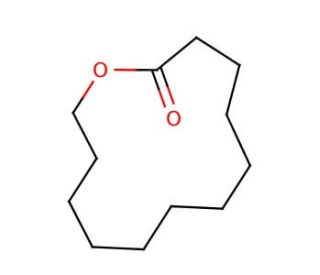
Click on image or enlarge button to enlarge

Oxacyclotridecan-2-one: sc-236256
Oxacyclotridecan-2-one (CAS 947-05-7)
CAS Number:
947-05-7
Molecular Weight:
198.30
Molecular Formula:
C12H22O2
For Research Use Only. Not Intended for Diagnostic or Therapeutic Use.
* Refer to Certificate of Analysis for lot specific data.
QUICK LINKS
Ordering Information
Description
Technical Information
Safety Information
SDS & Certificate of Analysis
Oxacyclotridecan-2-one, commonly referred to as a macrocyclic lactone, is a compound of interest primarily in the field of organic synthesis and material chemistry. It is studied for its potential as a starting material in the synthesis of various macrocyclic compounds, which are rings containing twelve or more atoms, that often exhibit unique physical and chemical properties due to their ring strain and conformational rigidity. This compound is also used as a building block in the creation of supramolecular structures, which are large entities formed from simple molecules through non-covalent interactions. Researchers are particularly interested in its ability to act as a host molecule in host-guest chemistry, where it can encapsulate smaller molecules within its cavity, leading to applications in molecular recognition and sensor design.
References:
- The reaction mechanism for the organocatalytic ring-opening polymerization of l-lactide using a guanidine-based catalyst: hydrogen-bonded or covalently bound? | Chuma, A., et al. 2008. J Am Chem Soc. 130: 6749-54. PMID: 18454532
- Fluorine and rhenium substituted ghrelin analogues as potential imaging probes for the growth hormone secretagogue receptor. | Rosita, D., et al. 2009. J Med Chem. 52: 2196-203. PMID: 19323558
- Bioproduction of lauryl lactone and 4-vinyl guaiacol as value-added chemicals in two-phase biotransformation systems. | Yang, J., et al. 2009. Appl Microbiol Biotechnol. 84: 867-76. PMID: 19444442
- Highly efficient macrolactonization of omega -hydroxy acids using benzotriazole esters: synthesis of Sansalvamide A. | Morales-Serna, JA., et al. 2010. Org Biomol Chem. 8: 4940-8. PMID: 20820651
- Coupling electrokinetics with microbial biodegradation enhances the removal of cycloparaffinic hydrocarbons in soils. | Yuan, Y., et al. 2016. J Hazard Mater. 320: 591-601. PMID: 27501882
- Antioxidant and apoptotic effects of Callistemon lanceolatus leaves and their compounds against human cancer cells. | Ahmad, K., et al. 2018. Biomed Pharmacother. 106: 1195-1209. PMID: 30119188
- RIFM fragrance ingredient safety assessment, oxacyclotridecan-2-one, CAS Registry Number 947-05-7. | Api, AM., et al. 2019. Food Chem Toxicol. 134 Suppl 1: 110928. PMID: 31678485
- Update to RIFM fragrance ingredient safety assessment, oxacyclotridecan-2-one, CAS Registry Number 947-05-7. | Api, AM., et al. 2022. Food Chem Toxicol. 165 Suppl 1: 113147. PMID: 35605711
- Preparation and evaluation of attractive microspheres for control of Agrilus planipennis fairmaire. | Li, YY., et al. 2023. J Environ Sci Health B. 58: 131-138. PMID: 36727586
- Fatty acid composition of bacteria associated with the toxic dinoflagellate Ostreopsis lenticularis and with Caribbean Palythoa species. | Carballeira, NM., et al. 1998. Lipids. 33: 627-32. PMID: 9655379
- Living ringopening polymerization of lactones using cationic zirconocene complex catalysts | Hayakawa, M., Mitani, M., Yamada, T., & Mukaiyama, T. 1997. Macromolecular Chemistry and Physics. 198(5): 1305-1317.
Ordering Information
| Product Name | Catalog # | UNIT | Price | Qty | FAVORITES | |
Oxacyclotridecan-2-one, 1 g | sc-236256 | 1 g | $60.00 |